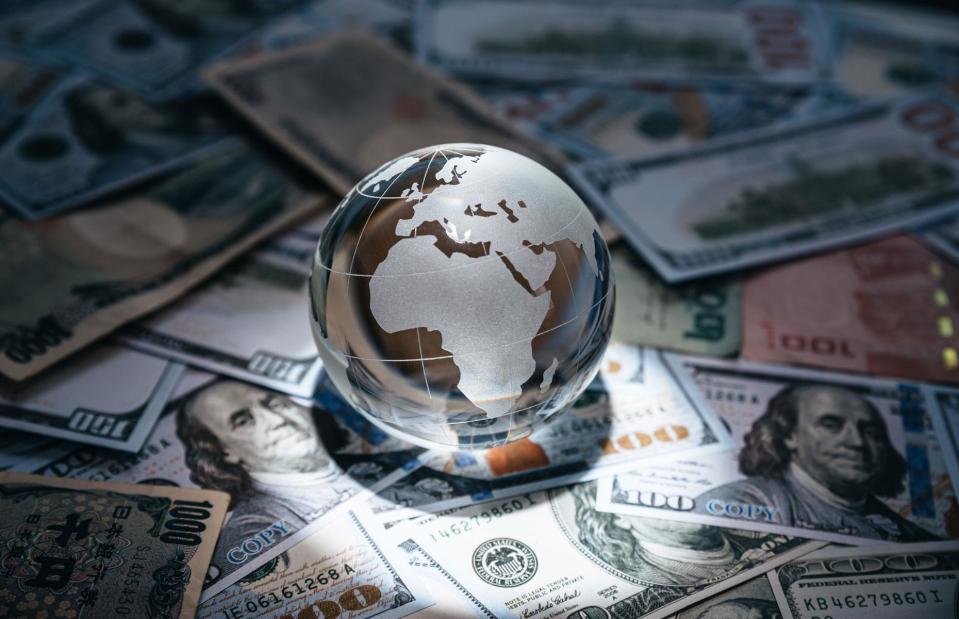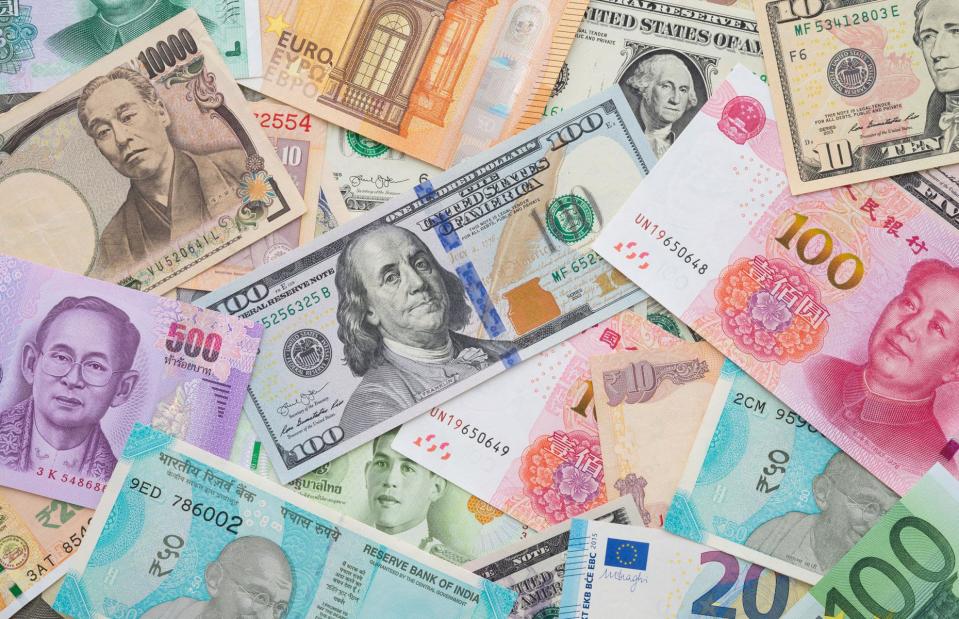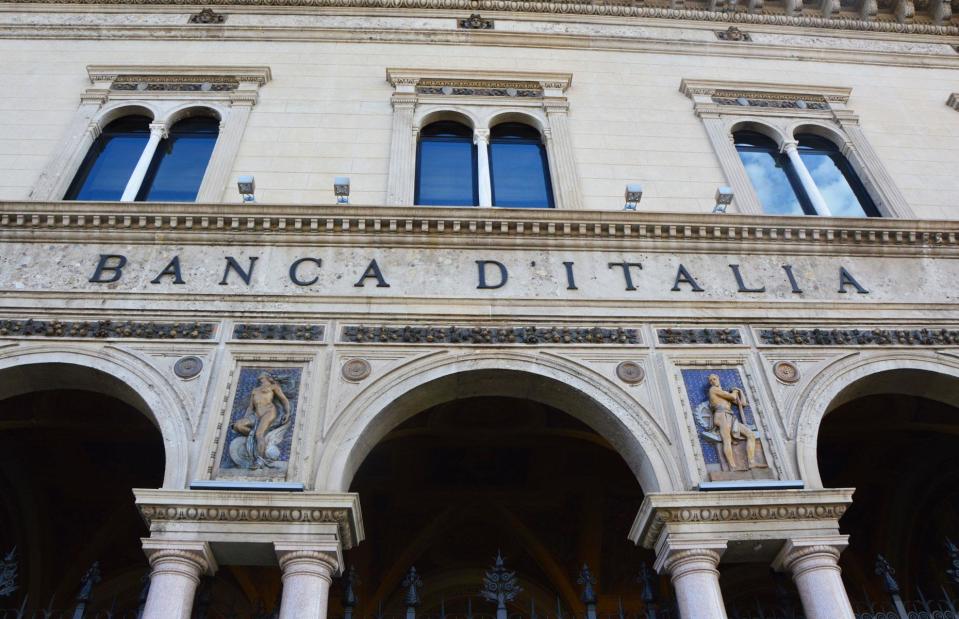Countries drowning in debt: How does the UK compare?
Countries living beyond their means

Thx4Stock team/Shutterstock
Global debt soared to a record $315 trillion (£248tn) earlier this year. That's more than three times the world's GDP, according to the Institute of International Finance (IIF), which tracks indebtedness across advanced and developing economies.
Shockingly, the last time global debt was this bad was during the Napoleonic Wars, more than 200 years ago. The current debt wave is the fourth since World War II and the largest to date, starting in 2010 and reaching unfathomed heights during the COVID-19 pandemic.
Since each previous wave has ended in misery, an unprecedented global debt crisis could be just around the corner. Read on to discover how the world has ended up in so much debt, and find out which countries could be heading for economic meltdown.
All dollar amounts in US dollars.
Record global debt

Pla2na/Shutterstock
There's no denying that the world is drowning in debt. But what does the record $315 trillion (£248tn) actually comprise?
Around $59.1 trillion (£47tn) is accounted for by household debt, which includes mortgages, credit cards, and student loans. Public debt represents $91.4 trillion (£72tn), while business debt stands at $164.5 trillion (£130tn). The figure also includes $70.4 trillion (£55tn) owed by the global financial sector.
Two-thirds of the world's debt is owed by advanced economies, with developing nations accounting for the rest. Still, in relative terms, debt among emerging economies has ballooned in recent years, having almost doubled to $105 trillion (£83tn) from $55 trillion (£43tn) a decade ago. If the debt were divided equally, every person on the planet would owe $39,000 (£31k).
COVID borrowing and spiralling interest payments

PAUL ELLIS/AFP via Getty Images
Global debt increased steadily during the 2010s. However, it ballooned at the start of the COVID-19 pandemic in 2020 as governments scrambled to support households and businesses impacted by the virus and associated lockdowns.
By the time the world opened up again in 2021, strong demand coupled with supply chain disruption had pushed up inflation. Then, Russia's invasion of Ukraine in 2022 exacerbated the already onerous inflationary pressures. Central banks have responded by doing what was considered unthinkable a decade ago: hiking up interest rates by several percentage points (and significantly more in some cases).
This has had the desired effect of dampening inflation, although the interest rate increases have made debt more expensive to service and rates remain elevated, making it harder to service debt.
How do governments manage debt?

Warrick Page/Getty Images
Worryingly, the current high levels of debt have come about at a time of swelling budget deficits, generally high interest rates, and chronically low global growth. Most governments are unable to grow themselves out of their rising debts, and managing the punishing interest payments is becoming increasingly challenging.
Outside of punishing austerity measures, some governments have the option of issuing securities such as bonds, or simply printing more money to limit their IOUs. However, selling securities and debt monetisation only tend to work well for advanced economies such as Japan and the US, while they often lead to economic ruin for emerging economies. For instance, Argentina, Zimbabwe, and Venezuela experienced rampant hyperinflation when their governments went on money-printing sprees in an attempt to pay off their debts.
What do governments do if they can't pay their debts?

Bumble Dee/Shutterstock
When debts become unsustainable, governments usually have no choice but to go cap in hand to the IMF (or similar) and beg for a bailout. This invariably comes with strings attached, such as requirements to rein in government spending.
In the worst case scenario, countries default on their debt repayments. A sovereign debt default really is the last resort as it can lead to dire economic consequences. Worryingly, sovereign debt defaults have climbed to record levels.
According to Fitch Ratings, an unprecedented nine countries are currently in default or have had their rating withdrawn: Belarus, El Salvador, Russia, Suriname, Ethiopia, Ghana, Lebanon, Sri Lanka, and Zambia.
The importance of a sovereign good credit rating

T. Schneider/Shutterstock
A country's creditworthiness can make all the difference to its ability to service its debts, especially if most of its liabilities are denominated in foreign currency and owed to overseas creditors. These ratings are set by a number of agencies, including Fitch Ratings, Standard & Poor (S&P), and Moody's.
In the past, advanced economies tended to have stellar sovereign credit ratings, enjoying the most favourable interest rates. In recent years, however, some leading economies, including America, have seen their ratings downgraded.
On the flip side, developing countries are mainly saddled with poor credit ratings and have to pay a stiff premium, making borrowing considerably more expensive as it's considered more risky to lend to them.
What is the debt-to-GDP ratio and why is it important?

Yuriy K/Shutterstock
The debt-to-GDP ratio compares a country's debt to its annual economic output. This metric is a good indicator of a nation's ability to sustain its debts. As a general rule of thumb, the higher the ratio, the harder it is for the country to service its liabilities.
That said, the rule isn't set in stone, and as we’ll see, there are some notable exceptions today.
With all that in mind, let's take a look at the gross debt-to-GDP ratios of 20 of the world’s key economies and assess how likely they are to avoid a debt meltdown...
Russia, debt-to-GDP ratio: 20.8%

Adriana Mahdalova/Getty
Russia's sovereign debt amounts to $428.5 billion (£337bn), which equates to just 20.8% of the country's GDP. Following its annexation of Crimea in 2014, the Putin regime set out to sanction-proof the nation's economy and keep external debt to a minimum by exercising strict fiscal and monetary restraint.
Buttressed by the country's wealth of commodities and huge trade surplus, the debt-busting strategy has helped Putin fund his invasion of Ukraine and better deal with the resulting economic fallout.
However, Russia's long-term financial future looks bleak. While keeping debt low, the policy has deprived public services of funding and sapped growth. And with Russia cut off from the global banking system and its credit rating massively downgraded – the country actually defaulted in 2022 as a result of Western sanctions – it couldn't borrow on the international markets now even if it wanted to.
Switzerland, debt-to-GDP ratio: 36.7%

Oli Scarff/Getty Images
As countries go, Switzerland is a dream borrower, boasting the highest possible AAA credit rating across the leading rating agencies. Its government is renowned for prudent management of the economy and the Swiss franc is among the world's go-to reserve currencies.
Since 2003, the Swiss government has adhered to an unyielding debt brake, which has helped to keep sovereign debt levels low.
Thanks to the state's aversion to getting in the red, the nation's public debt currently stands at $344.4 billion (£270bn), which translates to just 36.7% of Switzerland's annual economic output.
New Zealand, debt-to-GDP ratio: 47.4%

ChameleonsEye/Shutterstock
New Zealand has more reasons than most other countries to keep its public debt under control. The country is particularly vulnerable to costly natural disasters, such as earthquakes and destructive storms, not to mention external economic shocks due to its small size and export-driven economy.
As a result, successive governments have worked hard to keep debt levels low. The current grand total of $122.1 billion (£96bn) is the equivalent of a modest 47.4% of the country's GDP. The government is aiming to get that ratio down to between 20% and 40%.
But it's not all good news. Less borrowing means less money to invest, and New Zealand is now facing an infrastructure deficit, which has led to calls for the government to raise the debt ceiling. It certainly wouldn't cost much, relatively, given that New Zealand is rated AAA by Moody's and AA, the second-highest grade, by the other main rating agencies.
Australia, debt-to-GDP ratio: 49.6%

Sociopath987/Shutterstock
Australia's gross sovereign debt amounts to $887.8 billion ($698bn), equating to 49.6% of the country's GDP.
Like neighbouring New Zealand, Australia has much lower relative public debt levels than many other high-income nations. Liabilities have risen since 2008 when net debt was in negative territory, with COVID spending the biggest outlay in recent years.
Yet sound financial stewardship – combined with Australia's resource-rich economy, fat trade surplus, and agency-wide triple A credit rating – have kept debt more than manageable. The ratio is expected to widen as government spending on infrastructure, education, and defence increases, but the projected figure of 58% by 2027 is still low by international standards.
Mexico, debt-to-GDP ratio: 55.6%

Lennin Domínguez/ObturadorMX/Getty Images
Mexico's nightmare debt crises of the 1980s and 1990s were clearly a wake-up call. Since then, the country has diligently repaired its reputation as a reliable borrower and Mexican bonds are now deemed investment grade by the key credit rating agencies.
The nation's gross sovereign debt comes in at $1.1 trillion (£865bn), which is 55.6% of its GDP. Debt has piled up this year, however, as outgoing President Andrés Manuel López Obrador ramped up borrowing to fund extra public spending in the run-up to June's general election.
Mexico's incoming president, Claudia Sheinbaum, faces the prospect of having to hike taxes to deliver on her pledge to boost spending on welfare and public services.
Germany, debt-to-GDP ratio: 63.7%

dpa picture alliance/Alamy
Germany boasts glowing AAA ratings from all the key credit reference agencies and its gross national debt is comparatively modest at $2.92 trillion (£2tn), which translates to 63.7% of the country's GDP. And while the figure exceeds the EU target of 60% outlined in the Maastricht Treaty, it's well below the OECD average and EU average of 81.7%.
Despite all these favourable factors, worries over Germany's public debt levels are prevalent and official caution over taking on debt is actually proving problematic.
Last November, the German government was plunged into turmoil when its 2024 budget was scuppered by the constitutional court for falling foul of the country's debt brake, which is enshrined in the German Constitution. Critics argue the obsession with fiscal discipline could undermine growth and even slow the nation's green transition.
Austria, debt-to-GDP ratio: 75.4%

Nick Higham/Alamy
Neighbouring Austria's debt-to-GDP ratio also exceeds the 60% Maastricht Treaty threshold. But like Germany's, it's still lower than both the OCED and EU averages.
The nation's sovereign debt is currently $407.8 billion (£321bn). However, Austria's debt is relatively higher than that of Germany (and other peers) and impacts its credit rating, according to Fitch. The country is rated a rung below Germany by the three top agencies.
Government spending reached record levels in 2023, though the debt burden was offset by strong economic growth and an inflation-driven rise in revenue, according to Statistics Austria.
South Africa, debt-to-GDP ratio: 75.4%

RODGER BOSCH/AFP via Getty Images
Like many other developing countries, South Africa's bonds are rated poorly by the leading credit reference agencies.
This poor credit rating raises borrowing costs, so even though the country's debt-to-GDP ratio isn't overly high by global standards, South Africa's current debt of $281.4 billion (£221bn) is becoming difficult to sustain. (For comparison purposes: Austria has the same debt-to-GDP ratio, although its interest payments are much lower.)
Minister of Finance Enoch Godongwana has admitted the cost of servicing the debt is now eating into social spending. Incredibly, this year's interest payments, which are estimated at $20.7 billion (£16bn), far eclipse South Africa's basic education budget and exceed the country's military expenditure for 2024 seven-fold.
India, debt-to-GDP ratio: 82.5%

Sudarshan negi/Shutterstock
The IMF has sounded the alarm on India's growing debt-to-GDP ratio. At 82.5% of the nation's GDP, the country's sovereign debt has surged to $3.25 trillion (£2.56tn) – and the ratio could surpass 100% in the medium term. India's bonds are investment grade but have the lowest rating in this category, so paying off the increased debt could be challenging as interest is likely to be high.
The Indian government has played down the dangers, pointing out that a large chunk of the nation's sovereign debt is denominated in rupees, which decreases the risk of a debt crisis developing as there are relatively few foreign creditors to satisfy.
Argentina, debt-to-GDP ratio: 86.2%

FABRICE COFFRINI/AFP via Getty Images
Argentina has defaulted on its sovereign debt three times since 2001 and has had to turn to the IMF twice to restructure its liabilities.
Few countries have a poorer credit rating and the country faces an uphill struggle to pay its dues, which have come about as a result of years of economic mismanagement and government overspending. The figure stands at $520.9 billion (£409bn).
Right-wing populist Javier Milei was elected president in December 2023 after campaigning to slash government expenditure and debt. While his economic shock therapy treatment appears to be working in some areas, reducing the national debt won't be easy. Leading financial forecasting firm Oxford Economics pegs the probability of Argentina defaulting on its debts between 2025 and 2027 at 75%.
China, debt-to-GDP ratio: 88.6%

Pictures Ltd./Corbis via Getty Images
China's debt situation isn't looking great. With the country mired in an economic slump brought about by its crashing property sector, the government is poised to borrow its way out of the downturn. That's according to Fitch, which downgraded China's credit outlook to negative in April.
Officially, China's sovereign debt amounts to $16.42 trillion (£13tn), the equivalent of 88.6% of its GDP. But finance firm Fidelity asserts the figure could actually be as high as 130% if "shadow financing tools", which effectively fuelled the property crisis, are factored in. The revised number would place China among the most indebted emerging markets in relative terms.
UK, debt-to-GDP ratio: 104.3%

Dan Kitwood/Getty Images
The UK's gross sovereign debt stands at $3.65 trillion (£3tn). This is $150 billion (£118bn) greater than the nation's annual economic output, resulting in a debt-to-GDP ratio of 104.3%. Around 25% of this debt is held by foreign investors, which is significantly higher than the advanced economy average of 18%.
Servicing the debt has become more expensive as inflation and interest rates have risen. The highest monthly layout has exceeded $26 billion (£20bn), though the UK enjoys preferential deals courtesy of its strong credit rating, which is in the upper A category.
Looking ahead, Rachel Reeves, who seems likely to be Chancellor of the Exchequer following the country's general election on 4 July, has made tackling national debt one of the key rules underpinning the Labour Party's economic policy.
Canada, debt-to-GDP ratio: 104.7%

Kevin Dietsch/Getty Images
Chrystia Freeland, Canada's Deputy Prime Minister and Minister of Finance has made it her priority to slim down the country's bloated pandemic-boosted debt-to-GDP ratio, which she says has to decline if Canada's finances are to remain sustainable. At $2.35 trillion (£2tn), it exceeds the nation's GDP by 4%.
The minister's plan appears to working, as Canada's debt-to-GDP is coming down. The IMF recently issued a glowing review of the Canadian economy and praised the government's efforts to reduce its debt levels.
Spain, debt-to-GDP ratio: 106.3%

Jose Miguel Sanchez/Shutterstock
Spain's debt-to-GDP ratio climbed a hefty 20% between 2020 and 2021. That's more than any other Eurozone country, with the pandemic both hampering growth and leading to enormous spending from the Spanish government as a result.
Today, the nation's public debt comes in at $1.75 trillion (£1.4tn), equivalent to 106.3% of its GDP. Its credit rating is decent and varies from A (S&P) to Baa1 (Moody's).
Although the absolute figure remains high, Spain's debt-to-GDP ratio has been trending down due to strong economic growth and other tailwinds, such as larger-than-expected tax receipts.
France, debt-to-GDP ratio: 111.6%

LUDOVIC MARIN/AFP via Getty Images
France also saw its debt-to-GDP ratio increase as a consequence of the pandemic and other external shocks. The debt pile now totals $3.49 trillion (£3tn), which is 111.6% of the country's GDP.
France is having a harder time than Spain when it comes to reducing its debt-to-GDP ratio, with President Macron's government unable to rein in spending and lower the deficit. The nation has paid a heavy price for missing its debt-reduction targets: on 1 June, S&P downgraded France's credit rating from AA to AA-.
A humiliating demotion for the country, the rate cut puts it in the same creditworthiness class as the Czech Republic and Estonia.
USA, debt-to-GDP ratio: 123.3%

Jemal Countess/Getty Images for the Peter G. Peterson Foundation
In absolute terms, the US is the world's most indebted country. It currently owes an astronomical $35.49 trillion (£28tn) – equivalent to $102,474 (£80k) for each American – which is 123.3% of the nation's GDP.
The Government Accountability Office recently warned that the country is on an unsustainable fiscal path that presents a grave threat to the economy, national security, and society. The growing debt-to-GDP ratio, which is expected to hit 166% by 2054, could stymie growth and drain government budgets as interest payments balloon. Indeed, US debt repayments are set to exceed defence spending for the first time in 2024.
Last year's debt ceiling crisis resulted in a rating downgrade from Fitch and an outlook downgrade from Moody's, which have made servicing US debt more expensive. In terms of creditors, Japan holds the most US debt, followed by China and the UK.
Italy, debt-to-GDP ratio: 139.2%

Zigres/Shutterstock
Up to its eyeballs in IOUs, Italy has amassed a $3.24 trillion (£2.5tn) sovereign debt load, which represents 139.2% of the country's total yearly output. Italy's debt situation has been looking positive of late amid the country's impressive post-pandemic recovery, and last November saw Moody's change its outlook from negative to stable.
But according to the IMF, Italy's future economic wellbeing is at stake if its government fails to address the escalating debt mountain. Italy is in a more vulnerable position that many other nations with high debt-to-GDP ratios as a significant share of its debt is foreign-owned and 20% is owed to private creditors. This exposes it to speculative attacks, according to French credit insurer Coface.
Greece, debt-to-GDP ratio: 148.8%

Milos Bicanski/Getty Images
Greece lived beyond its means for decades until the late noughties, when the nation was plunged into a catastrophic debt crisis. A textbook example of what happens to a country when its debt levels become unsustainable, the Greek government was forced to introduce sweeping spending cuts and steep tax hikes, impoverishing many. It also had to secure bailouts from the IMF, European Central Bank, and Eurogroup.
Greece still isn't out of the woods. Its bonds are poorly rated by Moody's and the country will be paying off its creditors until 2060. Its debt currently stands at $372.4 billion (£290bn), which equates to 148.8% of GDP.
On the upside, the ratio is forecast to decrease gradually over the next few years and the debt does appear manageable. It's mostly held by official creditors which, in contrast to Italy's debt, makes it less exposed to speculation.
Singapore, debt-to-GDP ratio: 162.5%

Shadow of light/Shutterstock
Singapore is something of an anomaly. Its gross sovereign debt comes in at a substantial $853.5 billion (£669bn), which translates to a debt-to-GDP ratio of 162.5%.
But the compact island nation's credit rating is outstanding, with AAA grades all round, while its fiscal health is also excellent. So, what's going on?
Unlike other highly indebted countries, Singapore borrows to invest rather than spend – this is actually written into its constitution – and the nation's assets considerably exceed its liabilities. So much so, in fact, that the country actually has zero net debt.
Japan, debt-to-GDP ratio: 254.6%

f11photo/Shutterstock
Japan's external debt snowballed during the "Lost Decade" of the 1990s and has since spiralled. Heavy borrowing to pay for a rapidly ageing population and stimulate the perennially stagnant economy continues unabated, having risen to eye-watering levels during the pandemic. Japan's debt now stands at $10.46 trillion (£8tn), which is more than two-and-a-half times its GDP.
Other countries would be in severe crisis with this level of debt. But Japan is doing just fine, with its creditworthiness in the A category. Japan's debt is mostly held in yen, which is itself a leading reserve currency, and owned domestically, so the lion's share of liabilities is subject to the country's minuscule interest rates.
The Japanese government also has a healthy current account surplus and ranks as the leading holder of US debt. This is certainly one country that won't go bankrupt any time soon.
Now discover how much the average person earns in different countries around the world

 Yahoo Finance
Yahoo Finance 